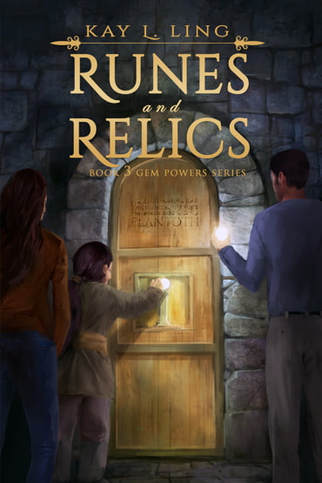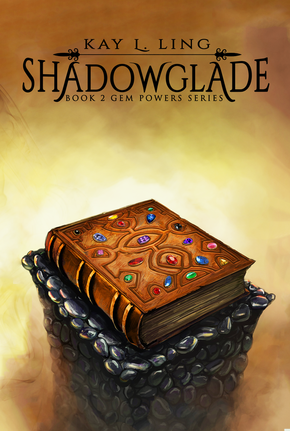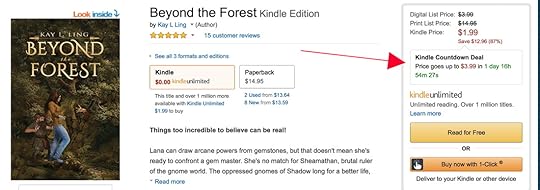Kay L. Ling's Blog
September 10, 2018
Gems - Facts and Fiction

In my Gem Powers Series, Lana Grayson, a young gemologist, delves into gemstone folklore and is fascinated to learn that people once believed that gems had amazing powers. According to her books, gems could protect the user from danger, signal the presence of poison, and even turn the wearer invisible.
Centuries ago, it was common to wear amulets and talismans made of semi-precious or precious gems. Today, gem folklore exists, but you're not likely to read about any of the more farfetched powers. Instead, you'll read about physical and emotional healing properties. While researching this topic, I discovered a vast number of obscure and interesting gems.
In the opening of Beyond the Forest, Lana has learned to tap deeply into gems' energy, but so far she's only mastered gems with rather mundane powers. When she discovers the gnome world and learns that taking gems from our world there amplifies their abilities, and that their native gems have incredible powers, her curiosity lands her in the middle of dangerous adventures with far-reaching effects.
By the end of the Gem Powers Series, Lana and her human allies have changed the course of gnome history, and the focus of the story shifts to what lies ahead for the gnomes. A spinoff series, the Gem Lore Series, begins a new story arc with predominantly gnome viewpoint characters, but humans from the original series do make appearances. The second series concentrates on native gems, and since I’m not limited to the folklore ascribed to real gems, I can create anything I like. Some gems have benevolent powers and others have dangerous abilities. In our own world, gems always have beneficial properties, so the gnome world is quite different in that respect.
I've enjoyed creating a magic system based on gems. Many readers have commented that it was fun to learn about gemstone folklore, and they'll never look at their jewelry in quite the same way as before.
Myths and Mentors, book two in the Gem Lore Series, was just released in paperback on Amazon with the eBook to follow on October 24, 2018. The first book in the series, Wards and Wonders, is available now in eBook and paperback.
Published on September 10, 2018 11:29
January 21, 2018
What Do You Call the Female Equivalent of a “Bromance”?

A few popular fantasy novels feature two male characters that have a close bond, and they're almost like brothers. People refer to their relationship as a “bromance.” But where are the books with a similar bond between female characters? There may be some, but offhand, I can’t think of any.
After struggling to write the blurb for my upcoming novel, Wards and Wonders, I realized I was using the wrong angle. I was focusing on the plot, not the characters.
Before starting this book, I had thought how much fun it would be to develop an unlikely friendship between two radically different females—Tyla a gnome, and Tina Ann, a deformed, genetically altered gnome called a breghlin. Not only are their appearances different, Tyla does research and runes translation at Elantoth Fortress, and Tina Ann works in the kitchen. Tyla is levelheaded and staid. Tina Ann is uncouth and unpredictable. Before long, the developing friendship between this unlikely pair drives a wedge between Tyla and her real sister, Arenia. I enjoyed watching this relationship unfold as the book progressed, and I think readers will, too.
So, despite all the fascinating plot points I had hoped to work into my blurb, Tyla and Tina Ann’s friendship took center stage. I have no idea what readers will call the female equivalent of a bromance, but I’ve given fantasy fiction two very memorable friends who share a sister-like bond.
Published on January 21, 2018 09:47
September 29, 2017
That's Inhuman!

Fantasy novels of previous decades often included elves, dwarves, orcs, or goblins, but today, most authors limit themselves to human characters. So, why does my series have gnomes and their savage, deformed counterparts, the breghlin? Because non-human characters are fun!
Gnomes have human-like desires and motivations, but certain aspects of their world and culture make them unique. The breghlin, bred by Sheamathan to be her servant race, are ugly, crude, and have few morals, and they don't always think like gnomes much less like humans. Many readers enjoy them more than the gnomes and root for them as they evolve into beings with a conscience who want to better themselves.
I had planned to include more than three books in the Gem Power series, but the focus of the story changes at the end of book three, so it makes more sense to create a spinoff series.
In the Gem Powers Series, human main characters try to free the gnomes from an oppressive ruler and help them become self-governing. This story is best told by humans. In the Gem Lore Series, gnomes face new struggles and unimagined adventures as they try to rebuild their lives. Not only is this story best told by gnomes, the majority can't be told by humans. Explaining why would be a spoiler for anyone who hasn't completed the first series, so I'll leave it at that.
If you've enjoyed this series so far, I hope you'll spread the word. I try to make my stories light-hearted and uplifting, but they address serious themes as well. We can often learn valuable things about our own humanity through the eyes of non-human characters.
Published on September 29, 2017 12:15
August 3, 2017
Too Much of a Good Thing?

What's the ideal length of a fantasy series? Some readers prefer trilogies and others want to read a series with ten to fifteen books. It seems to me, depending on the frequency of new releases, long series can be too much of a good thing. Many readers refuse to begin a series until the last book is published, and who can blame them? A one-year wait that turns into five is frustrating enough, but some series have been abandoned, leaving the story unresolved.
The ideal solution seems to be shorter, interrelated series, providing readers with multiple entry points. The plot for my Gem Powers Series lends itself to this structure. The first three books take place in the gnome world and follow the adventures of human characters before and after they liberate gnomes from an oppressive ruler. The story is told from their viewpoints until we reach the end of book three. Then, we switch to a gnome viewpoint character, Tyla. Since the second series will open with Tyla, this makes a nice transition. Tyla and other gnomes will narrate the Gem Lore Series, rather than humans, which should appeal to readers who enjoy non-human main characters.
While there will be references to what has come before, readers whose entry point is the spinoff series won't feel lost. Once absorbed in the plot, I imagine many will want to read the first series to get the entire backstory. Reading in this order should be a different but equally enjoyable experience.
Runes and Relics, Book 3 in the Gem Powers Series, is coming this fall. Read the first two books now, or binge-read all three in October!
Readers, share your thoughts. What do you consider the ideal number of books in a series? Do you buy books as they're released, or do you typically wait and binge-read a finished series?
Published on August 03, 2017 11:31
May 4, 2017
A Recipe for Disaster and Laughter

I love fantasy novels, especially ones that aren't deadly serious and include a little comic relief. My novels don't include graphic violence, murder, or rape, but they do include danger, adventure, suspense . . . and humor.
Many reviews of Beyond the Forest mention humor. Readers say they particularly enjoyed the "rat-boys" and the dungeon guards. Shadowglade, just published in April, features a snarky, sentient spell book, which was supposed to be a minor "character" but became a pivotal part of the plot. The breghlin, monster-like mutant gnomes, continue to make readers laugh as Lana tries to civilize them and make them useful members of society.
In the next book, Runes and Relics, which I'm editing now, an exploration team composed of gnomes, breghlin, and humans must overcome long-held prejudices and work together to solve a problem facing the gnome world. As petty rivalries spring up and personalities clash, the dynamics have all the makings of a Reality TV show, and the story has its share of comic moments.
These books lead up to a second series in which humans are no longer central characters. I found the idea of a few gnomes and breghlin forming friendships and becoming main characters irresistible. The races couldn't be more different. Gnomes are moral and well mannered, and breghlin are lawless and crude. Putting them together is a recipe for disaster . . . and laughter. Once I finish editing Runes and Relics, I'll be back to work on book 4, which is partially written. You can be sure it will be sprinkled with comical misadventures and plenty of humor.
Published on May 04, 2017 11:04
March 4, 2017
SHADOWGLADE (Book 2 - Gem Powers Series)
 SHADOWGLADE (the book that follows Beyond the Forest) is coming soon and here’s the cover and the proposed blurb:
SHADOWGLADE (the book that follows Beyond the Forest) is coming soon and here’s the cover and the proposed blurb:It took teamwork and a clever plan to defeat the gnomes' gem master queen. And now, Lana and her allies face more dangers. Shadow is an ecological disaster. Monsters roam the land. And when Lana and her companions search the castle, they learn Sheamathan has a sentient spell book—with a bad attitude and instructions for revenge.
Imprisoned and bitter over her defeat, Sheamathan eagerly awaits the coming disasters that will punish her enemies, both human and gnome. She believes that even if they survive, there's little chance the gnomes will discover their history, or learn the secrets she's kept for generations.
But the spell book will surprise them all, changing everything.
Published on March 04, 2017 14:48
February 23, 2017
Themes Happen
 When I write, my goal is to tell an enjoyable story. I don’t try to make a philosophical point. Even so, themes happen, and I discover them when reflecting on the finished book.
When I write, my goal is to tell an enjoyable story. I don’t try to make a philosophical point. Even so, themes happen, and I discover them when reflecting on the finished book.
In Shadowglade, The Gem Powers Series Book 2, which I plan to publish in April, Lana champions the cause of Sheamathan’s former servant race, the goblin-like breghlin. They’re savage, crude, and disgusting, and everyone sees them as monsters. Lana sees that side of them too, but she also sees their potential. Their ruler, Sheamathan, belittled and mistreated them their entire lives and encouraged their savagery, so it’s little wonder they’re monsters. Lana realizes many breghlin will never change, but she believes some will if they’re treated with kindness and respect.
I haven’t read every book in the fantasy genre, but offhand, I can’t think of any others where evil monsters become likeable characters. In my series, it’s a slow evolution beginning with Lana’s stay in the dungeon when she discovers her guards have one-letter “names.” When she gives them “real names,” it sparks their desire to be valued as individuals, and that becomes a catalyst for change.
By the end of book two, the breghlin are still crude, but they’re gaining self-respect and a sense of right and wrong. This trend continues in book three, and by book four (which is half-written as I prepare to publish two and three) some of the breghlin have become main characters, taking important roles along with gnomes.
When I began book one, I never expected my monsters to become “good guys.” But like Lana, I couldn’t hate them. Despite their outward appearance and bad behavior, I was willing to believe they could change. Their evolution is ongoing, but some of my “monsters” surprise me with their courage and integrity. I’m glad I gave them the chance to prove themselves.
Published on February 23, 2017 11:13
January 19, 2017
Give Me a Tale That Isn't Stale
 I became hooked on the fantasy genre and read little else during the 1980s and 1990s. Back then, most fantasy novels were set in pseudo-medieval lands based on Britain or Western Europe. Many of these stories involved a quest to find a sword, a book, or some other powerful artifact. Many were epic sagas, involving wars between human kingdoms, or conflicts between humans and faeries, elves, or dwarves. Nearly all had male protagonists, and women were relegated to stereotypical, insignificant roles.
I became hooked on the fantasy genre and read little else during the 1980s and 1990s. Back then, most fantasy novels were set in pseudo-medieval lands based on Britain or Western Europe. Many of these stories involved a quest to find a sword, a book, or some other powerful artifact. Many were epic sagas, involving wars between human kingdoms, or conflicts between humans and faeries, elves, or dwarves. Nearly all had male protagonists, and women were relegated to stereotypical, insignificant roles.Eventually, I became burned-out on fantasy. I had read too many books about quests and wars, too many stories about farmhands or orphans with newly-discovered powers who must single-handedly save the day. Today, many books continue to follow these time-worn tropes, and there's nothing wrong with that, but when I read a synopsis with these elements, I usually pass and choose a different book.
There are many fresh voices in fantasy today who are creating interesting characters and highly imaginative worlds. And perhaps because women read more books than men, female main characters have finally become common, particularly in the urban fantasy subgenre.
Although I prize originality, no fantasy novel is completely original, including my own. My books center around one common fantasy trope—a portal to another world. The nice thing about portal stories is that, for the imaginative writer, there are endless possibilities of what lies on the other side. My standalone novel became a series when ideas about the world I created and its cultures continued to evolve.
In book one, Beyond the Forest, Lana's adventures take place in a small part of the gnome world, Shadow, and whatever we know about Shadow is based on what little she's seen. We learn that Shadow's geology and gemstones differ from ours. Their gems have stronger, more impressive powers and some are harmful. For the most part, Lana concentrates on gems from her own world and has limited interaction with Shadow gems. We also learn that Shadow has everything from diseased forests to deserts within a small area. Sheamathan, the gnomes' ruler, purposely destroyed the ecology and created monstrous creatures that could survive in these new habitats.
In book two, Lana wants to learn more about Shadow, but the gnomes have lived in hiding for generations, and know little about their history or what lies beyond the areas they've occupied for generations. They hope to rediscover their heritage and explore their world, but that will be difficult unless they subdue the breghlin and form a government. As the human characters continue to help the gnomes and breghlin, we learn more about Shadows' fascinating array of gemstones.
Books two and three explore in greater depth a subject touched upon in book one: something about Shadow inexplicably affects human and gnome biology. Evil behavior results in physical mutations, which partially explains the breghlin's deformities. Sheamathan capitalized on this and through genetic manipulation created mutations that permanently disfigured her servant race. The gnomes must shun evil or they'll become like the breghlin, and that influences every aspect of their lives.
My goal in this series is to transport readers to a world that feels as real as our own but surprises them at every turn with differences that are sometimes delightful and sometimes creepy. The races the reader meets prove thought-provoking as well as entertaining. Each book in the series reveals more about gnome and breghlin cultures and explores more of their world. While the human characters continue to play important roles, the story becomes increasingly centered on the inhabitants of Shadow, and by book four gnomes and breghlin are the main characters.
Writing this series becomes more challenging as the plot and themes grow more complex, but I find it exciting to watch the story unfold, and I hope readers will too.
Published on January 19, 2017 11:07
December 18, 2016
My Kindle Countdown Results are in!
 Here's the wrap-up on my campaign: Dec. 8-14, 2016.
Here's the wrap-up on my campaign: Dec. 8-14, 2016.I spent $258.50 on promotions to augment the Kindle Countdown. Along with these promos I ran AMS (Amazon Marketing Services) ads and posted notifications on Twitter, my Facebook personal account and author page, and sent out a few emails and PMs.
The promo sites I used with amounts spent are:
EBooksHabit - $10
EBook Betty - $18
EReaderIQ - $10
MyBookCave - $15
Reading Deals - $29
ENT - $30
SweetFreeBooks - $7
Book Pebble - Free
Booktastic - $10
ManyBooks - $19
eBookChristian - $5.50
Bookoftheday.org - Free
BookRaid - cost per click- inexpensive
Bookzio - $19
FreeDiscountedBooks - $8
BookLoversHeaven- $5
Just Kindle Books - $15
Choosy Bookworm - $25
People Reads - $9
BargaineBookHunter - $24 (two days)
My results: I sold 118 eBooks, 7 paperbacks, and had KENP reads (Kindle Edition Normalized Pages) totaling 2,678. Prior to this promotion I'd had very little KENP.
My results weren't stellar, but my sales rank improved from 220,992 to 2902, new readers and KindleUnlimited borrowers discovered my book, and I hope to get more word-of-mouth reader referrals and written reviews.
Many authors launch books at a steep discount, simultaneously running promo ads, hoping to achieve a more favorable sales rank and heightened visibility. As a new author with no prior books to testify to my competence, I took a different approach. I priced my 414-page fantasy novel at $3.99 and did a soft launch, only notifying Advance Reader Copy reviewers that the book was "live." A few days later, when I a had a handful of reviews, I asked Amazon to send the "now available" email to people who had nominated my book for Kindle Scout, and I posted notifications on Facebook and Twitter. My theory was that readers would be more likely to take a chance on an unknown author's work if they could read a few positive reviews. During my first thirty days I accumulated additional reviews, and at the end of the month I scheduled a Kindle Countdown deal and booked a number of promos.
It's impossible to know whether this approach generated more sales and reviews than some other launch strategy, but I'm satisfied with the results. Before the Countdown deal I had very few also-boughts and minimal KENP. Now I have nineteen pages of also-boughts and I'm getting daily KENP. Hopefully, the boost in sales rank will produce ongoing benefits and my book will find a wider readership. In the meantime, I'm editing the second book in this series, Shadowglade, which should be available in Spring 2017.
Published on December 18, 2016 09:36
December 13, 2016
Kindle Countdown Catastrophe

It's tough being a debut author. There's so much you can do wrong even after seeking guidance from others. I recently attempted my first Kindle Countdown deal, and I thought I knew what I was doing, but despite my research on the KBoards, there was plenty I didn't know. I'll share my mistakes so you won't repeat them!
1. Unbeknown to me, you can manually set the start time of your Countdown. I didn't notice the dropdown menu. The default start time is 8:00 AM Pacific. Many promo newsletters go out early in the morning, so 8:00 AM is much too late. Your discount needs to be in place before the newsletters go out. Most promo services check your price before including your ad in their newsletter. If your price hasn't been reduced, they won't run your ad. Furthermore, you risk being banned from using their services in the future. This is not an idle threat. More about that later!
2. You can structure your Countdown deal to have more than one price. I selected a seven-day Countdown with two price points. The default setting split my campaign into two equal segments of three and a half days. I suspect I could have manually adjusted this so I had a full day at one price or the other, and in retrospect, that would have been more sensible. Instead, I simply avoided confusion by not booking any promos for that day.
3. Canada is NOT included in a Countdown deal, only the US and the UK, and if you want a Countdown in the UK you need to set up a separate campaign. I discovered this too late to make the timing coincide with my US Countdown deal. I salvaged the situation as best I could by belatedly adding a UK Countdown which started 8 AM GST. No doubt I should have moved that start time earlier as well, but I was in damage control mode and too rattled to think clearly.
Usually when computer programs have a default setting it's wise to use the suggested setting. Not so with Amazon! My Countdown fiasco taught me that, if nothing else. Explore all your options and review your selections one last time before your campaign goes "live." Your campaigns cannot be altered in any way when you're within 24 hours of the start time. You can't even view your settings.
So, what happened to my cancelled promotions you ask? Did I lose my fees? Did the providers ban me from future promos? No, fortunately. After I explained what happened, both of the promos that had omitted my ad graciously agreed to move my promo to the following day. In some cases, this would not have been possible as certain sites limit the number of books they promote per day.
Many authors launch debut novels with a flurry of promos, hoping for lots of sales and reviews. I used a different approach. I started at full price and depended on ARCs for a handful of early reviews. In my next post I'll explain more about my strategy and the results.
Published on December 13, 2016 08:00



